Analysis of Mr. Curtis's Case Study in the High Dependency Unit
VerifiedAdded on 2022/09/28
|11
|3205
|23
Case Study
AI Summary
This case study analyzes a 74-year-old patient, Mr. Curtis, admitted to the High Dependency Unit (HDU) for cholecystectomy, focusing on his medical history of hypertension and myocardial infarctions, and current diagnosis of atrial fibrillation and acute pulmonary edema. The analysis includes interpretation of electrocardiogram (ECG) results indicating atrial fibrillation and arterial blood gas (ABG) results revealing abnormalities in oxygen and carbon dioxide levels. The study explores the causes, including age, hypertension, and myocardial infarction, and treatment options like anticoagulants, cardioversion, and medications such as flecainide and sotalol. It also discusses the pathology of acute pulmonary edema, its causes, and the importance of urgent medical attention. The patient assessment includes an evaluation of vital signs and the implementation of interventions like glyceryl trinitrate, oxygen administration, positive airway pressure, and medications such as frusemide and morphine. The document also provides a systematic assessment of the patient's condition, including airway, breathing, gastrointestinal system, and renal status, along with the symptoms of acute pulmonary edema and the associated pathophysiology.
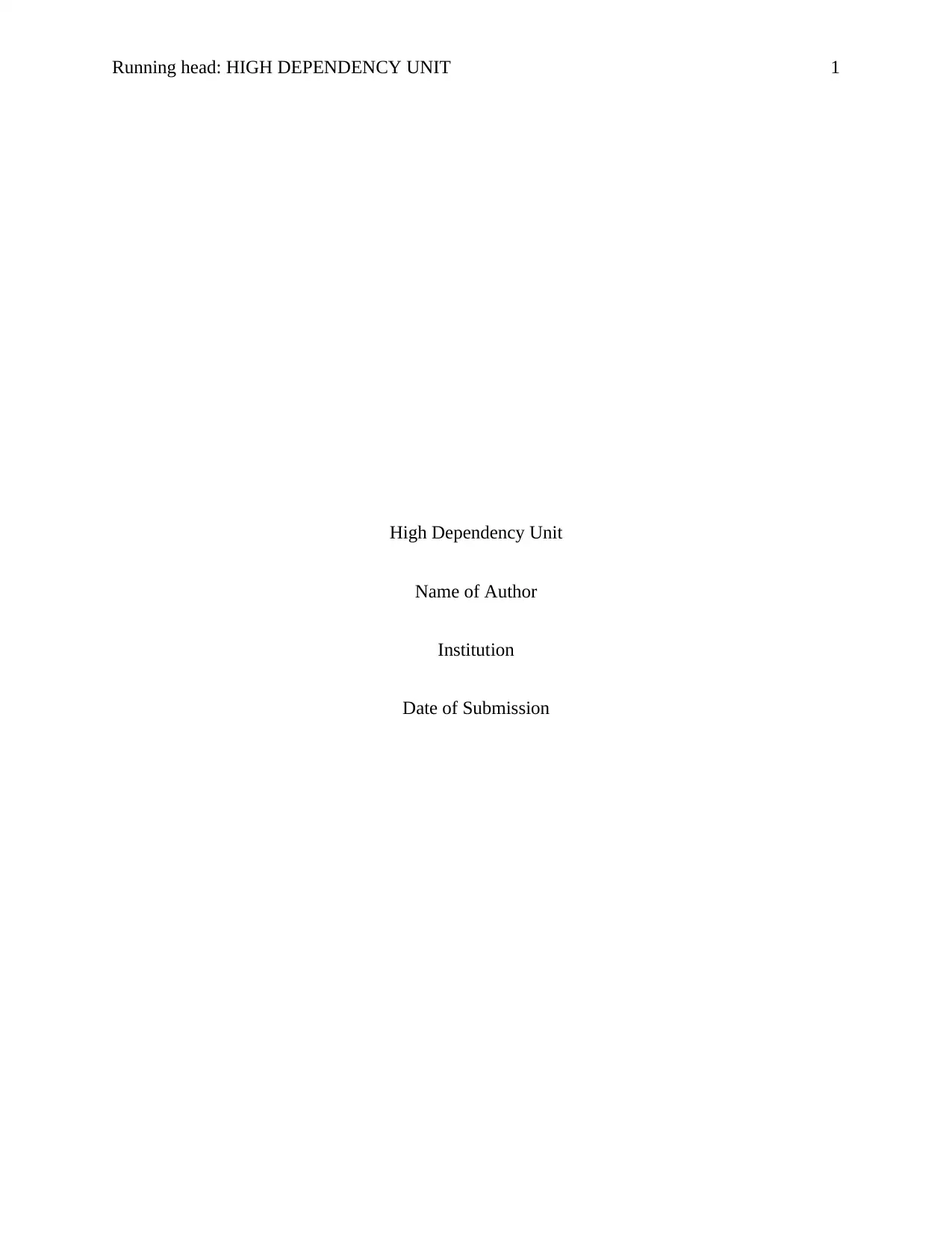
Running head: HIGH DEPENDENCY UNIT 1
High Dependency Unit
Name of Author
Institution
Date of Submission
High Dependency Unit
Name of Author
Institution
Date of Submission
Paraphrase This Document
Need a fresh take? Get an instant paraphrase of this document with our AI Paraphraser
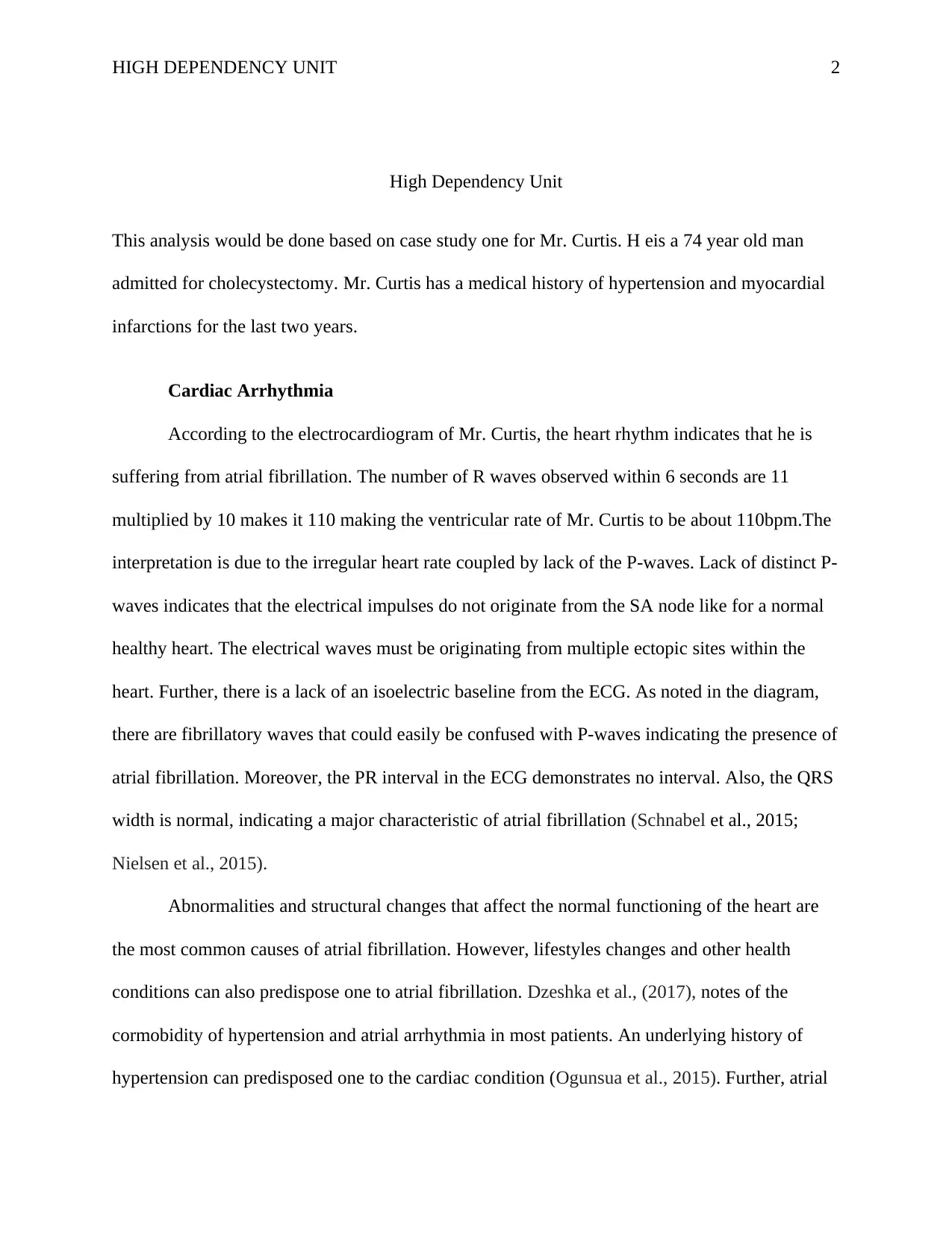
HIGH DEPENDENCY UNIT 2
High Dependency Unit
This analysis would be done based on case study one for Mr. Curtis. H eis a 74 year old man
admitted for cholecystectomy. Mr. Curtis has a medical history of hypertension and myocardial
infarctions for the last two years.
Cardiac Arrhythmia
According to the electrocardiogram of Mr. Curtis, the heart rhythm indicates that he is
suffering from atrial fibrillation. The number of R waves observed within 6 seconds are 11
multiplied by 10 makes it 110 making the ventricular rate of Mr. Curtis to be about 110bpm.The
interpretation is due to the irregular heart rate coupled by lack of the P-waves. Lack of distinct P-
waves indicates that the electrical impulses do not originate from the SA node like for a normal
healthy heart. The electrical waves must be originating from multiple ectopic sites within the
heart. Further, there is a lack of an isoelectric baseline from the ECG. As noted in the diagram,
there are fibrillatory waves that could easily be confused with P-waves indicating the presence of
atrial fibrillation. Moreover, the PR interval in the ECG demonstrates no interval. Also, the QRS
width is normal, indicating a major characteristic of atrial fibrillation (Schnabel et al., 2015;
Nielsen et al., 2015).
Abnormalities and structural changes that affect the normal functioning of the heart are
the most common causes of atrial fibrillation. However, lifestyles changes and other health
conditions can also predispose one to atrial fibrillation. Dzeshka et al., (2017), notes of the
cormobidity of hypertension and atrial arrhythmia in most patients. An underlying history of
hypertension can predisposed one to the cardiac condition (Ogunsua et al., 2015). Further, atrial
High Dependency Unit
This analysis would be done based on case study one for Mr. Curtis. H eis a 74 year old man
admitted for cholecystectomy. Mr. Curtis has a medical history of hypertension and myocardial
infarctions for the last two years.
Cardiac Arrhythmia
According to the electrocardiogram of Mr. Curtis, the heart rhythm indicates that he is
suffering from atrial fibrillation. The number of R waves observed within 6 seconds are 11
multiplied by 10 makes it 110 making the ventricular rate of Mr. Curtis to be about 110bpm.The
interpretation is due to the irregular heart rate coupled by lack of the P-waves. Lack of distinct P-
waves indicates that the electrical impulses do not originate from the SA node like for a normal
healthy heart. The electrical waves must be originating from multiple ectopic sites within the
heart. Further, there is a lack of an isoelectric baseline from the ECG. As noted in the diagram,
there are fibrillatory waves that could easily be confused with P-waves indicating the presence of
atrial fibrillation. Moreover, the PR interval in the ECG demonstrates no interval. Also, the QRS
width is normal, indicating a major characteristic of atrial fibrillation (Schnabel et al., 2015;
Nielsen et al., 2015).
Abnormalities and structural changes that affect the normal functioning of the heart are
the most common causes of atrial fibrillation. However, lifestyles changes and other health
conditions can also predispose one to atrial fibrillation. Dzeshka et al., (2017), notes of the
cormobidity of hypertension and atrial arrhythmia in most patients. An underlying history of
hypertension can predisposed one to the cardiac condition (Ogunsua et al., 2015). Further, atrial
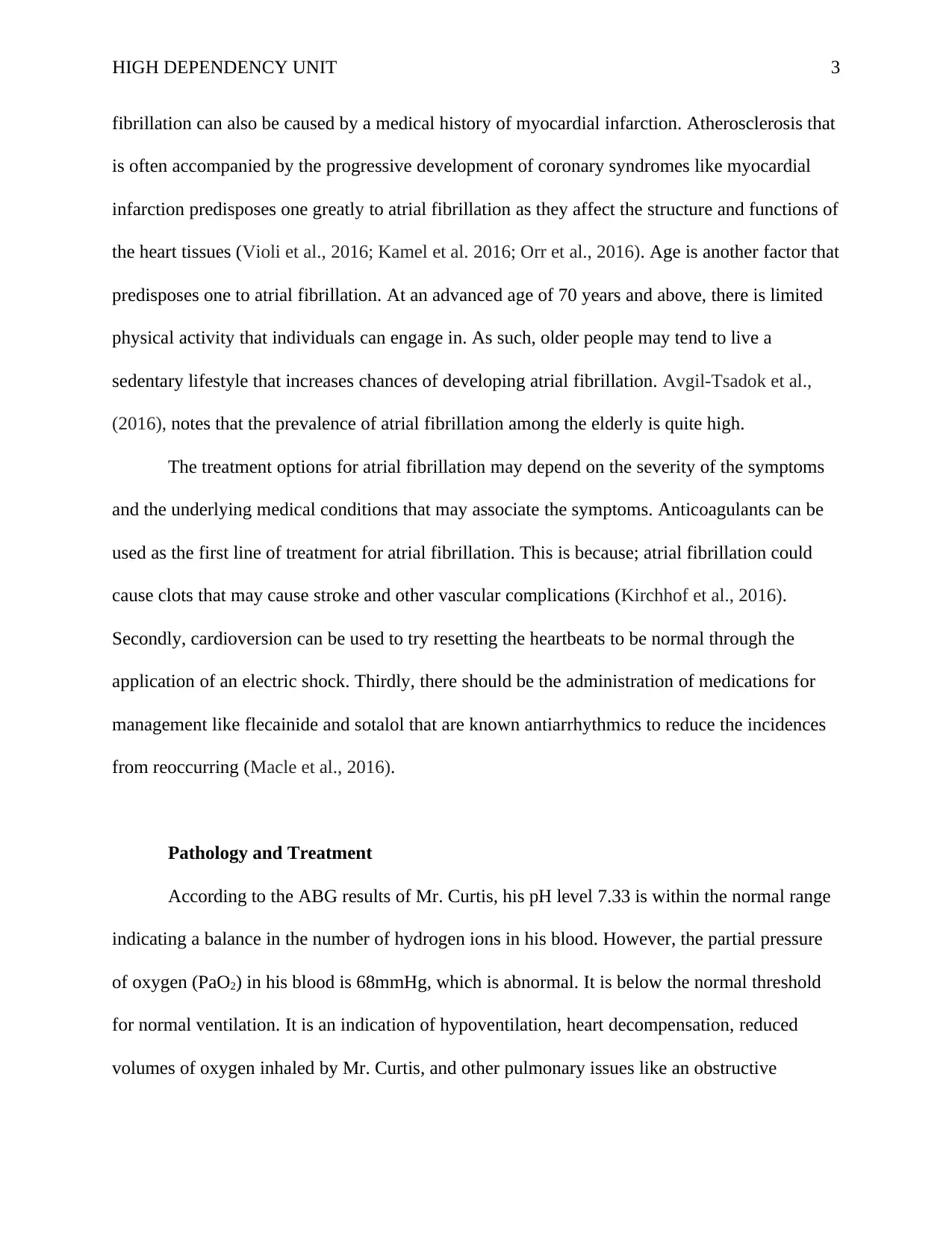
HIGH DEPENDENCY UNIT 3
fibrillation can also be caused by a medical history of myocardial infarction. Atherosclerosis that
is often accompanied by the progressive development of coronary syndromes like myocardial
infarction predisposes one greatly to atrial fibrillation as they affect the structure and functions of
the heart tissues (Violi et al., 2016; Kamel et al. 2016; Orr et al., 2016). Age is another factor that
predisposes one to atrial fibrillation. At an advanced age of 70 years and above, there is limited
physical activity that individuals can engage in. As such, older people may tend to live a
sedentary lifestyle that increases chances of developing atrial fibrillation. Avgil-Tsadok et al.,
(2016), notes that the prevalence of atrial fibrillation among the elderly is quite high.
The treatment options for atrial fibrillation may depend on the severity of the symptoms
and the underlying medical conditions that may associate the symptoms. Anticoagulants can be
used as the first line of treatment for atrial fibrillation. This is because; atrial fibrillation could
cause clots that may cause stroke and other vascular complications (Kirchhof et al., 2016).
Secondly, cardioversion can be used to try resetting the heartbeats to be normal through the
application of an electric shock. Thirdly, there should be the administration of medications for
management like flecainide and sotalol that are known antiarrhythmics to reduce the incidences
from reoccurring (Macle et al., 2016).
Pathology and Treatment
According to the ABG results of Mr. Curtis, his pH level 7.33 is within the normal range
indicating a balance in the number of hydrogen ions in his blood. However, the partial pressure
of oxygen (PaO2) in his blood is 68mmHg, which is abnormal. It is below the normal threshold
for normal ventilation. It is an indication of hypoventilation, heart decompensation, reduced
volumes of oxygen inhaled by Mr. Curtis, and other pulmonary issues like an obstructive
fibrillation can also be caused by a medical history of myocardial infarction. Atherosclerosis that
is often accompanied by the progressive development of coronary syndromes like myocardial
infarction predisposes one greatly to atrial fibrillation as they affect the structure and functions of
the heart tissues (Violi et al., 2016; Kamel et al. 2016; Orr et al., 2016). Age is another factor that
predisposes one to atrial fibrillation. At an advanced age of 70 years and above, there is limited
physical activity that individuals can engage in. As such, older people may tend to live a
sedentary lifestyle that increases chances of developing atrial fibrillation. Avgil-Tsadok et al.,
(2016), notes that the prevalence of atrial fibrillation among the elderly is quite high.
The treatment options for atrial fibrillation may depend on the severity of the symptoms
and the underlying medical conditions that may associate the symptoms. Anticoagulants can be
used as the first line of treatment for atrial fibrillation. This is because; atrial fibrillation could
cause clots that may cause stroke and other vascular complications (Kirchhof et al., 2016).
Secondly, cardioversion can be used to try resetting the heartbeats to be normal through the
application of an electric shock. Thirdly, there should be the administration of medications for
management like flecainide and sotalol that are known antiarrhythmics to reduce the incidences
from reoccurring (Macle et al., 2016).
Pathology and Treatment
According to the ABG results of Mr. Curtis, his pH level 7.33 is within the normal range
indicating a balance in the number of hydrogen ions in his blood. However, the partial pressure
of oxygen (PaO2) in his blood is 68mmHg, which is abnormal. It is below the normal threshold
for normal ventilation. It is an indication of hypoventilation, heart decompensation, reduced
volumes of oxygen inhaled by Mr. Curtis, and other pulmonary issues like an obstructive
⊘ This is a preview!⊘
Do you want full access?
Subscribe today to unlock all pages.

Trusted by 1+ million students worldwide
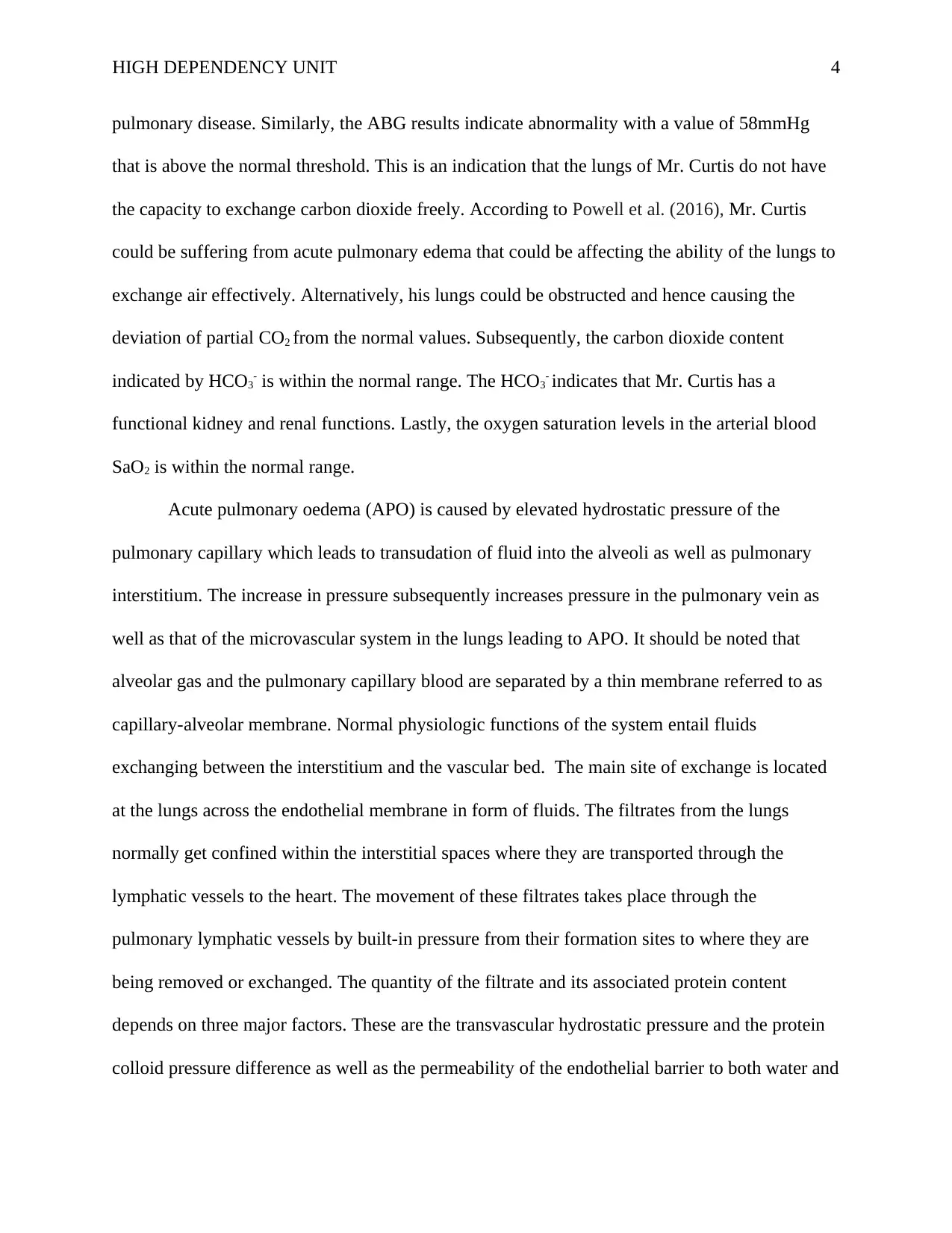
HIGH DEPENDENCY UNIT 4
pulmonary disease. Similarly, the ABG results indicate abnormality with a value of 58mmHg
that is above the normal threshold. This is an indication that the lungs of Mr. Curtis do not have
the capacity to exchange carbon dioxide freely. According to Powell et al. (2016), Mr. Curtis
could be suffering from acute pulmonary edema that could be affecting the ability of the lungs to
exchange air effectively. Alternatively, his lungs could be obstructed and hence causing the
deviation of partial CO2 from the normal values. Subsequently, the carbon dioxide content
indicated by HCO3- is within the normal range. The HCO3- indicates that Mr. Curtis has a
functional kidney and renal functions. Lastly, the oxygen saturation levels in the arterial blood
SaO2 is within the normal range.
Acute pulmonary oedema (APO) is caused by elevated hydrostatic pressure of the
pulmonary capillary which leads to transudation of fluid into the alveoli as well as pulmonary
interstitium. The increase in pressure subsequently increases pressure in the pulmonary vein as
well as that of the microvascular system in the lungs leading to APO. It should be noted that
alveolar gas and the pulmonary capillary blood are separated by a thin membrane referred to as
capillary-alveolar membrane. Normal physiologic functions of the system entail fluids
exchanging between the interstitium and the vascular bed. The main site of exchange is located
at the lungs across the endothelial membrane in form of fluids. The filtrates from the lungs
normally get confined within the interstitial spaces where they are transported through the
lymphatic vessels to the heart. The movement of these filtrates takes place through the
pulmonary lymphatic vessels by built-in pressure from their formation sites to where they are
being removed or exchanged. The quantity of the filtrate and its associated protein content
depends on three major factors. These are the transvascular hydrostatic pressure and the protein
colloid pressure difference as well as the permeability of the endothelial barrier to both water and
pulmonary disease. Similarly, the ABG results indicate abnormality with a value of 58mmHg
that is above the normal threshold. This is an indication that the lungs of Mr. Curtis do not have
the capacity to exchange carbon dioxide freely. According to Powell et al. (2016), Mr. Curtis
could be suffering from acute pulmonary edema that could be affecting the ability of the lungs to
exchange air effectively. Alternatively, his lungs could be obstructed and hence causing the
deviation of partial CO2 from the normal values. Subsequently, the carbon dioxide content
indicated by HCO3- is within the normal range. The HCO3- indicates that Mr. Curtis has a
functional kidney and renal functions. Lastly, the oxygen saturation levels in the arterial blood
SaO2 is within the normal range.
Acute pulmonary oedema (APO) is caused by elevated hydrostatic pressure of the
pulmonary capillary which leads to transudation of fluid into the alveoli as well as pulmonary
interstitium. The increase in pressure subsequently increases pressure in the pulmonary vein as
well as that of the microvascular system in the lungs leading to APO. It should be noted that
alveolar gas and the pulmonary capillary blood are separated by a thin membrane referred to as
capillary-alveolar membrane. Normal physiologic functions of the system entail fluids
exchanging between the interstitium and the vascular bed. The main site of exchange is located
at the lungs across the endothelial membrane in form of fluids. The filtrates from the lungs
normally get confined within the interstitial spaces where they are transported through the
lymphatic vessels to the heart. The movement of these filtrates takes place through the
pulmonary lymphatic vessels by built-in pressure from their formation sites to where they are
being removed or exchanged. The quantity of the filtrate and its associated protein content
depends on three major factors. These are the transvascular hydrostatic pressure and the protein
colloid pressure difference as well as the permeability of the endothelial barrier to both water and
Paraphrase This Document
Need a fresh take? Get an instant paraphrase of this document with our AI Paraphraser
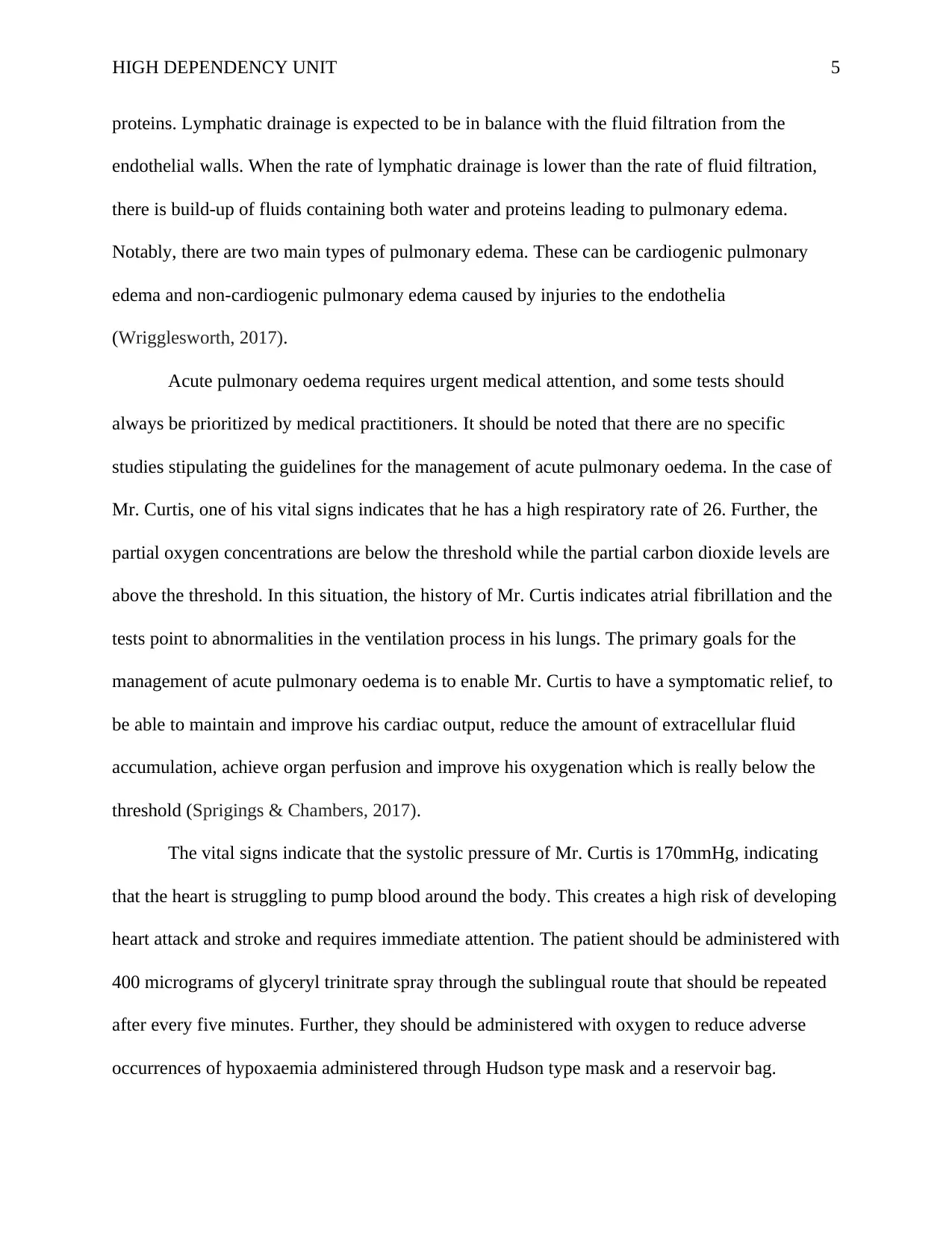
HIGH DEPENDENCY UNIT 5
proteins. Lymphatic drainage is expected to be in balance with the fluid filtration from the
endothelial walls. When the rate of lymphatic drainage is lower than the rate of fluid filtration,
there is build-up of fluids containing both water and proteins leading to pulmonary edema.
Notably, there are two main types of pulmonary edema. These can be cardiogenic pulmonary
edema and non-cardiogenic pulmonary edema caused by injuries to the endothelia
(Wrigglesworth, 2017).
Acute pulmonary oedema requires urgent medical attention, and some tests should
always be prioritized by medical practitioners. It should be noted that there are no specific
studies stipulating the guidelines for the management of acute pulmonary oedema. In the case of
Mr. Curtis, one of his vital signs indicates that he has a high respiratory rate of 26. Further, the
partial oxygen concentrations are below the threshold while the partial carbon dioxide levels are
above the threshold. In this situation, the history of Mr. Curtis indicates atrial fibrillation and the
tests point to abnormalities in the ventilation process in his lungs. The primary goals for the
management of acute pulmonary oedema is to enable Mr. Curtis to have a symptomatic relief, to
be able to maintain and improve his cardiac output, reduce the amount of extracellular fluid
accumulation, achieve organ perfusion and improve his oxygenation which is really below the
threshold (Sprigings & Chambers, 2017).
The vital signs indicate that the systolic pressure of Mr. Curtis is 170mmHg, indicating
that the heart is struggling to pump blood around the body. This creates a high risk of developing
heart attack and stroke and requires immediate attention. The patient should be administered with
400 micrograms of glyceryl trinitrate spray through the sublingual route that should be repeated
after every five minutes. Further, they should be administered with oxygen to reduce adverse
occurrences of hypoxaemia administered through Hudson type mask and a reservoir bag.
proteins. Lymphatic drainage is expected to be in balance with the fluid filtration from the
endothelial walls. When the rate of lymphatic drainage is lower than the rate of fluid filtration,
there is build-up of fluids containing both water and proteins leading to pulmonary edema.
Notably, there are two main types of pulmonary edema. These can be cardiogenic pulmonary
edema and non-cardiogenic pulmonary edema caused by injuries to the endothelia
(Wrigglesworth, 2017).
Acute pulmonary oedema requires urgent medical attention, and some tests should
always be prioritized by medical practitioners. It should be noted that there are no specific
studies stipulating the guidelines for the management of acute pulmonary oedema. In the case of
Mr. Curtis, one of his vital signs indicates that he has a high respiratory rate of 26. Further, the
partial oxygen concentrations are below the threshold while the partial carbon dioxide levels are
above the threshold. In this situation, the history of Mr. Curtis indicates atrial fibrillation and the
tests point to abnormalities in the ventilation process in his lungs. The primary goals for the
management of acute pulmonary oedema is to enable Mr. Curtis to have a symptomatic relief, to
be able to maintain and improve his cardiac output, reduce the amount of extracellular fluid
accumulation, achieve organ perfusion and improve his oxygenation which is really below the
threshold (Sprigings & Chambers, 2017).
The vital signs indicate that the systolic pressure of Mr. Curtis is 170mmHg, indicating
that the heart is struggling to pump blood around the body. This creates a high risk of developing
heart attack and stroke and requires immediate attention. The patient should be administered with
400 micrograms of glyceryl trinitrate spray through the sublingual route that should be repeated
after every five minutes. Further, they should be administered with oxygen to reduce adverse
occurrences of hypoxaemia administered through Hudson type mask and a reservoir bag.
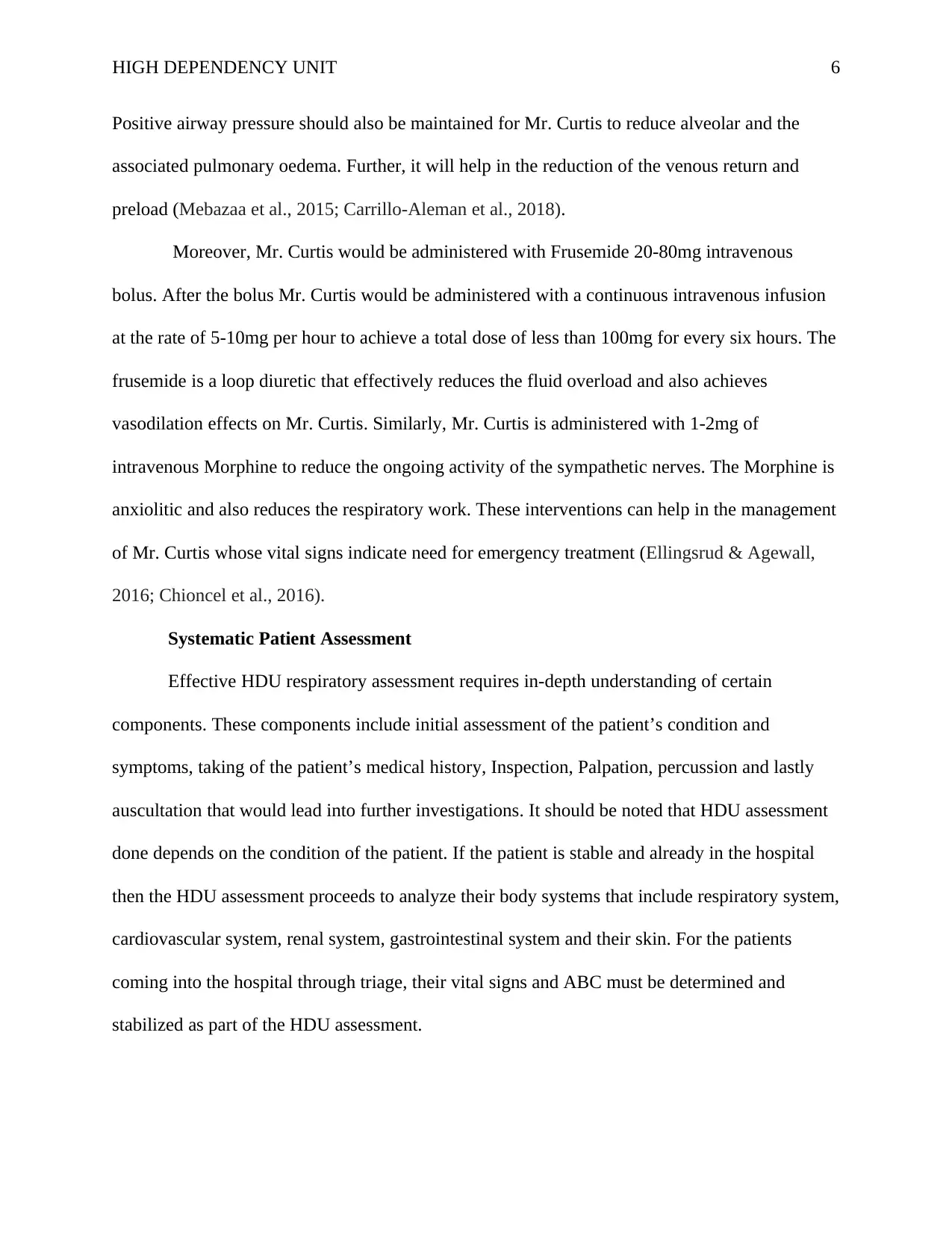
HIGH DEPENDENCY UNIT 6
Positive airway pressure should also be maintained for Mr. Curtis to reduce alveolar and the
associated pulmonary oedema. Further, it will help in the reduction of the venous return and
preload (Mebazaa et al., 2015; Carrillo-Aleman et al., 2018).
Moreover, Mr. Curtis would be administered with Frusemide 20-80mg intravenous
bolus. After the bolus Mr. Curtis would be administered with a continuous intravenous infusion
at the rate of 5-10mg per hour to achieve a total dose of less than 100mg for every six hours. The
frusemide is a loop diuretic that effectively reduces the fluid overload and also achieves
vasodilation effects on Mr. Curtis. Similarly, Mr. Curtis is administered with 1-2mg of
intravenous Morphine to reduce the ongoing activity of the sympathetic nerves. The Morphine is
anxiolitic and also reduces the respiratory work. These interventions can help in the management
of Mr. Curtis whose vital signs indicate need for emergency treatment (Ellingsrud & Agewall,
2016; Chioncel et al., 2016).
Systematic Patient Assessment
Effective HDU respiratory assessment requires in-depth understanding of certain
components. These components include initial assessment of the patient’s condition and
symptoms, taking of the patient’s medical history, Inspection, Palpation, percussion and lastly
auscultation that would lead into further investigations. It should be noted that HDU assessment
done depends on the condition of the patient. If the patient is stable and already in the hospital
then the HDU assessment proceeds to analyze their body systems that include respiratory system,
cardiovascular system, renal system, gastrointestinal system and their skin. For the patients
coming into the hospital through triage, their vital signs and ABC must be determined and
stabilized as part of the HDU assessment.
Positive airway pressure should also be maintained for Mr. Curtis to reduce alveolar and the
associated pulmonary oedema. Further, it will help in the reduction of the venous return and
preload (Mebazaa et al., 2015; Carrillo-Aleman et al., 2018).
Moreover, Mr. Curtis would be administered with Frusemide 20-80mg intravenous
bolus. After the bolus Mr. Curtis would be administered with a continuous intravenous infusion
at the rate of 5-10mg per hour to achieve a total dose of less than 100mg for every six hours. The
frusemide is a loop diuretic that effectively reduces the fluid overload and also achieves
vasodilation effects on Mr. Curtis. Similarly, Mr. Curtis is administered with 1-2mg of
intravenous Morphine to reduce the ongoing activity of the sympathetic nerves. The Morphine is
anxiolitic and also reduces the respiratory work. These interventions can help in the management
of Mr. Curtis whose vital signs indicate need for emergency treatment (Ellingsrud & Agewall,
2016; Chioncel et al., 2016).
Systematic Patient Assessment
Effective HDU respiratory assessment requires in-depth understanding of certain
components. These components include initial assessment of the patient’s condition and
symptoms, taking of the patient’s medical history, Inspection, Palpation, percussion and lastly
auscultation that would lead into further investigations. It should be noted that HDU assessment
done depends on the condition of the patient. If the patient is stable and already in the hospital
then the HDU assessment proceeds to analyze their body systems that include respiratory system,
cardiovascular system, renal system, gastrointestinal system and their skin. For the patients
coming into the hospital through triage, their vital signs and ABC must be determined and
stabilized as part of the HDU assessment.
⊘ This is a preview!⊘
Do you want full access?
Subscribe today to unlock all pages.

Trusted by 1+ million students worldwide
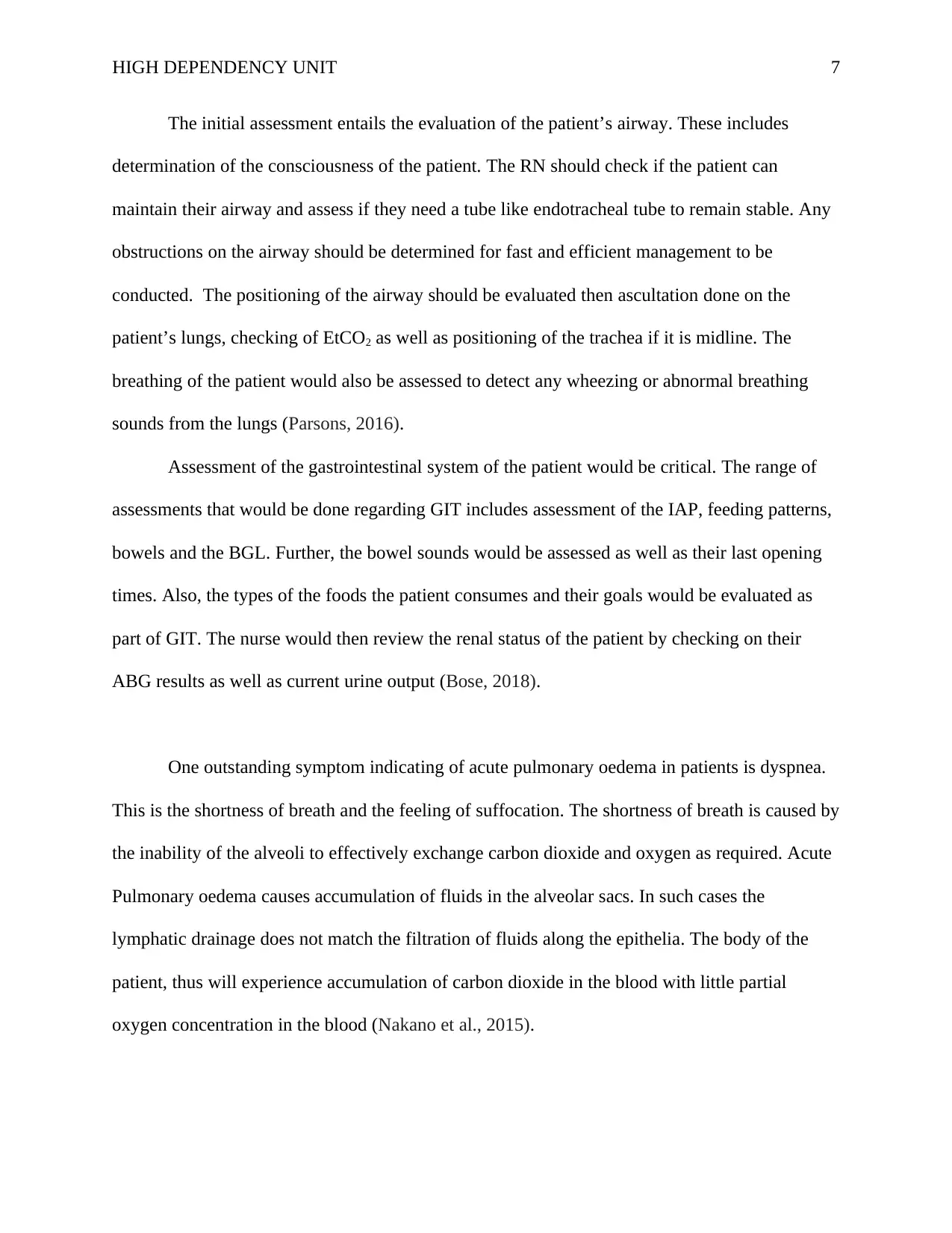
HIGH DEPENDENCY UNIT 7
The initial assessment entails the evaluation of the patient’s airway. These includes
determination of the consciousness of the patient. The RN should check if the patient can
maintain their airway and assess if they need a tube like endotracheal tube to remain stable. Any
obstructions on the airway should be determined for fast and efficient management to be
conducted. The positioning of the airway should be evaluated then ascultation done on the
patient’s lungs, checking of EtCO2 as well as positioning of the trachea if it is midline. The
breathing of the patient would also be assessed to detect any wheezing or abnormal breathing
sounds from the lungs (Parsons, 2016).
Assessment of the gastrointestinal system of the patient would be critical. The range of
assessments that would be done regarding GIT includes assessment of the IAP, feeding patterns,
bowels and the BGL. Further, the bowel sounds would be assessed as well as their last opening
times. Also, the types of the foods the patient consumes and their goals would be evaluated as
part of GIT. The nurse would then review the renal status of the patient by checking on their
ABG results as well as current urine output (Bose, 2018).
One outstanding symptom indicating of acute pulmonary oedema in patients is dyspnea.
This is the shortness of breath and the feeling of suffocation. The shortness of breath is caused by
the inability of the alveoli to effectively exchange carbon dioxide and oxygen as required. Acute
Pulmonary oedema causes accumulation of fluids in the alveolar sacs. In such cases the
lymphatic drainage does not match the filtration of fluids along the epithelia. The body of the
patient, thus will experience accumulation of carbon dioxide in the blood with little partial
oxygen concentration in the blood (Nakano et al., 2015).
The initial assessment entails the evaluation of the patient’s airway. These includes
determination of the consciousness of the patient. The RN should check if the patient can
maintain their airway and assess if they need a tube like endotracheal tube to remain stable. Any
obstructions on the airway should be determined for fast and efficient management to be
conducted. The positioning of the airway should be evaluated then ascultation done on the
patient’s lungs, checking of EtCO2 as well as positioning of the trachea if it is midline. The
breathing of the patient would also be assessed to detect any wheezing or abnormal breathing
sounds from the lungs (Parsons, 2016).
Assessment of the gastrointestinal system of the patient would be critical. The range of
assessments that would be done regarding GIT includes assessment of the IAP, feeding patterns,
bowels and the BGL. Further, the bowel sounds would be assessed as well as their last opening
times. Also, the types of the foods the patient consumes and their goals would be evaluated as
part of GIT. The nurse would then review the renal status of the patient by checking on their
ABG results as well as current urine output (Bose, 2018).
One outstanding symptom indicating of acute pulmonary oedema in patients is dyspnea.
This is the shortness of breath and the feeling of suffocation. The shortness of breath is caused by
the inability of the alveoli to effectively exchange carbon dioxide and oxygen as required. Acute
Pulmonary oedema causes accumulation of fluids in the alveolar sacs. In such cases the
lymphatic drainage does not match the filtration of fluids along the epithelia. The body of the
patient, thus will experience accumulation of carbon dioxide in the blood with little partial
oxygen concentration in the blood (Nakano et al., 2015).
Paraphrase This Document
Need a fresh take? Get an instant paraphrase of this document with our AI Paraphraser
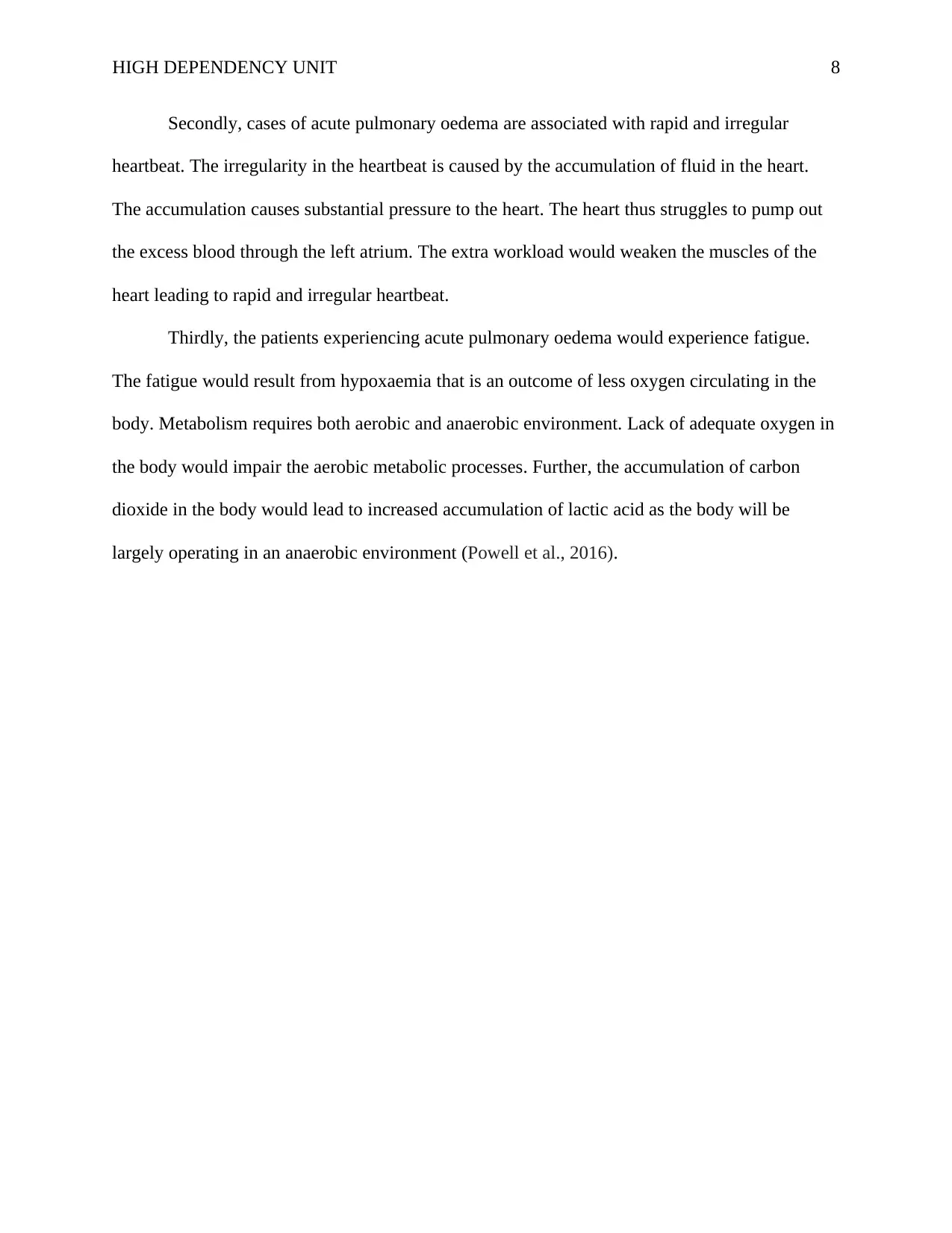
HIGH DEPENDENCY UNIT 8
Secondly, cases of acute pulmonary oedema are associated with rapid and irregular
heartbeat. The irregularity in the heartbeat is caused by the accumulation of fluid in the heart.
The accumulation causes substantial pressure to the heart. The heart thus struggles to pump out
the excess blood through the left atrium. The extra workload would weaken the muscles of the
heart leading to rapid and irregular heartbeat.
Thirdly, the patients experiencing acute pulmonary oedema would experience fatigue.
The fatigue would result from hypoxaemia that is an outcome of less oxygen circulating in the
body. Metabolism requires both aerobic and anaerobic environment. Lack of adequate oxygen in
the body would impair the aerobic metabolic processes. Further, the accumulation of carbon
dioxide in the body would lead to increased accumulation of lactic acid as the body will be
largely operating in an anaerobic environment (Powell et al., 2016).
Secondly, cases of acute pulmonary oedema are associated with rapid and irregular
heartbeat. The irregularity in the heartbeat is caused by the accumulation of fluid in the heart.
The accumulation causes substantial pressure to the heart. The heart thus struggles to pump out
the excess blood through the left atrium. The extra workload would weaken the muscles of the
heart leading to rapid and irregular heartbeat.
Thirdly, the patients experiencing acute pulmonary oedema would experience fatigue.
The fatigue would result from hypoxaemia that is an outcome of less oxygen circulating in the
body. Metabolism requires both aerobic and anaerobic environment. Lack of adequate oxygen in
the body would impair the aerobic metabolic processes. Further, the accumulation of carbon
dioxide in the body would lead to increased accumulation of lactic acid as the body will be
largely operating in an anaerobic environment (Powell et al., 2016).
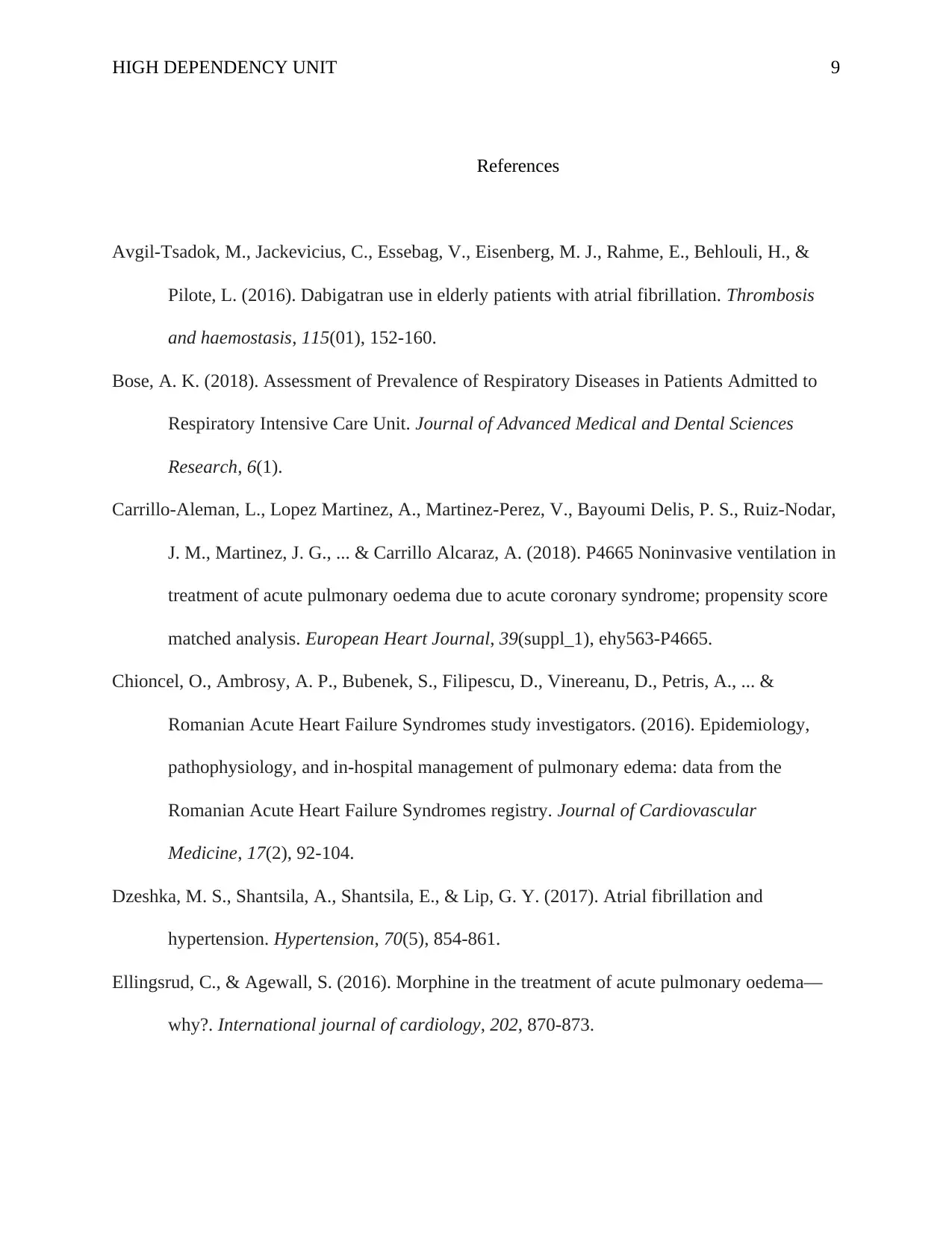
HIGH DEPENDENCY UNIT 9
References
Avgil-Tsadok, M., Jackevicius, C., Essebag, V., Eisenberg, M. J., Rahme, E., Behlouli, H., &
Pilote, L. (2016). Dabigatran use in elderly patients with atrial fibrillation. Thrombosis
and haemostasis, 115(01), 152-160.
Bose, A. K. (2018). Assessment of Prevalence of Respiratory Diseases in Patients Admitted to
Respiratory Intensive Care Unit. Journal of Advanced Medical and Dental Sciences
Research, 6(1).
Carrillo-Aleman, L., Lopez Martinez, A., Martinez-Perez, V., Bayoumi Delis, P. S., Ruiz-Nodar,
J. M., Martinez, J. G., ... & Carrillo Alcaraz, A. (2018). P4665 Noninvasive ventilation in
treatment of acute pulmonary oedema due to acute coronary syndrome; propensity score
matched analysis. European Heart Journal, 39(suppl_1), ehy563-P4665.
Chioncel, O., Ambrosy, A. P., Bubenek, S., Filipescu, D., Vinereanu, D., Petris, A., ... &
Romanian Acute Heart Failure Syndromes study investigators. (2016). Epidemiology,
pathophysiology, and in-hospital management of pulmonary edema: data from the
Romanian Acute Heart Failure Syndromes registry. Journal of Cardiovascular
Medicine, 17(2), 92-104.
Dzeshka, M. S., Shantsila, A., Shantsila, E., & Lip, G. Y. (2017). Atrial fibrillation and
hypertension. Hypertension, 70(5), 854-861.
Ellingsrud, C., & Agewall, S. (2016). Morphine in the treatment of acute pulmonary oedema—
why?. International journal of cardiology, 202, 870-873.
References
Avgil-Tsadok, M., Jackevicius, C., Essebag, V., Eisenberg, M. J., Rahme, E., Behlouli, H., &
Pilote, L. (2016). Dabigatran use in elderly patients with atrial fibrillation. Thrombosis
and haemostasis, 115(01), 152-160.
Bose, A. K. (2018). Assessment of Prevalence of Respiratory Diseases in Patients Admitted to
Respiratory Intensive Care Unit. Journal of Advanced Medical and Dental Sciences
Research, 6(1).
Carrillo-Aleman, L., Lopez Martinez, A., Martinez-Perez, V., Bayoumi Delis, P. S., Ruiz-Nodar,
J. M., Martinez, J. G., ... & Carrillo Alcaraz, A. (2018). P4665 Noninvasive ventilation in
treatment of acute pulmonary oedema due to acute coronary syndrome; propensity score
matched analysis. European Heart Journal, 39(suppl_1), ehy563-P4665.
Chioncel, O., Ambrosy, A. P., Bubenek, S., Filipescu, D., Vinereanu, D., Petris, A., ... &
Romanian Acute Heart Failure Syndromes study investigators. (2016). Epidemiology,
pathophysiology, and in-hospital management of pulmonary edema: data from the
Romanian Acute Heart Failure Syndromes registry. Journal of Cardiovascular
Medicine, 17(2), 92-104.
Dzeshka, M. S., Shantsila, A., Shantsila, E., & Lip, G. Y. (2017). Atrial fibrillation and
hypertension. Hypertension, 70(5), 854-861.
Ellingsrud, C., & Agewall, S. (2016). Morphine in the treatment of acute pulmonary oedema—
why?. International journal of cardiology, 202, 870-873.
⊘ This is a preview!⊘
Do you want full access?
Subscribe today to unlock all pages.

Trusted by 1+ million students worldwide
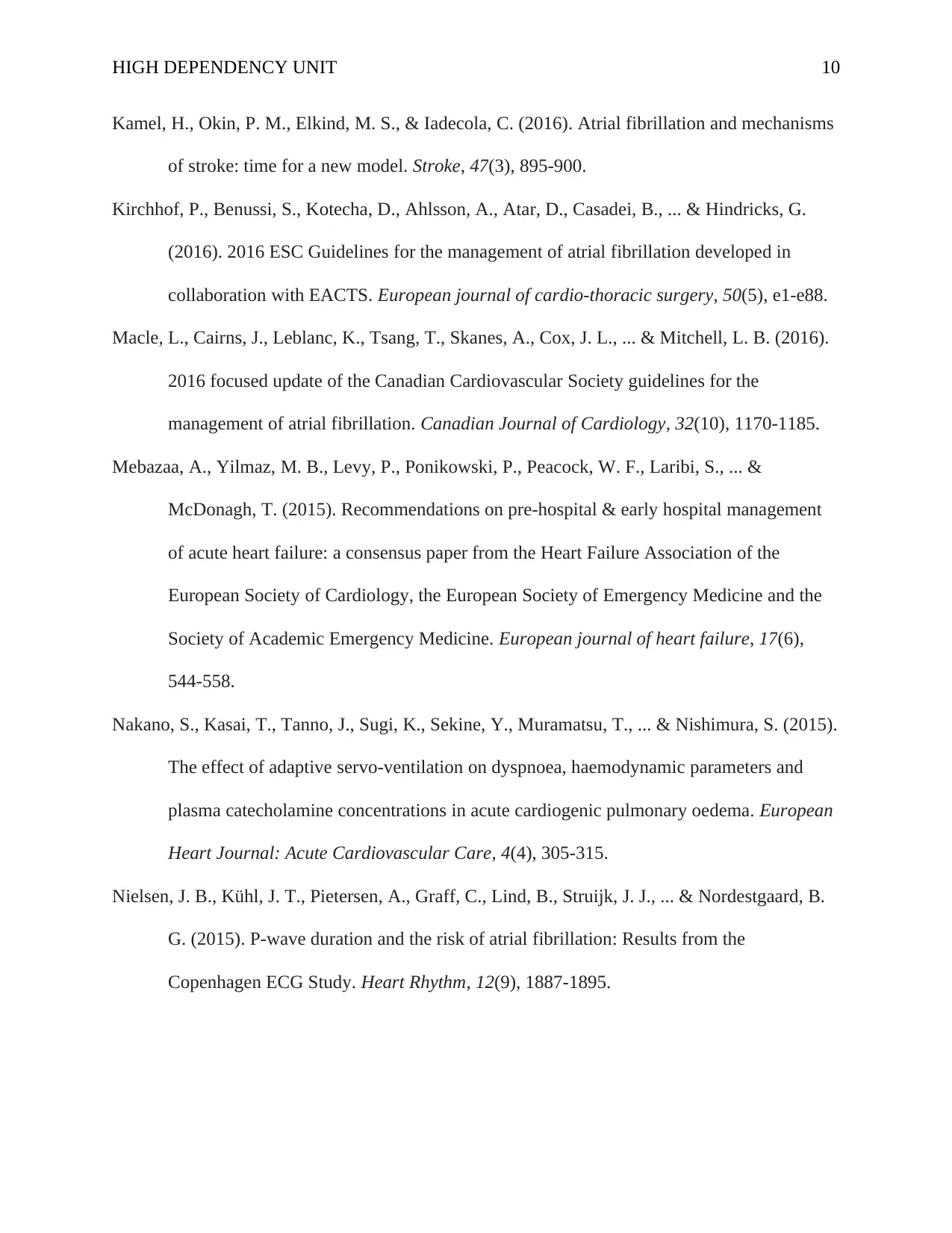
HIGH DEPENDENCY UNIT 10
Kamel, H., Okin, P. M., Elkind, M. S., & Iadecola, C. (2016). Atrial fibrillation and mechanisms
of stroke: time for a new model. Stroke, 47(3), 895-900.
Kirchhof, P., Benussi, S., Kotecha, D., Ahlsson, A., Atar, D., Casadei, B., ... & Hindricks, G.
(2016). 2016 ESC Guidelines for the management of atrial fibrillation developed in
collaboration with EACTS. European journal of cardio-thoracic surgery, 50(5), e1-e88.
Macle, L., Cairns, J., Leblanc, K., Tsang, T., Skanes, A., Cox, J. L., ... & Mitchell, L. B. (2016).
2016 focused update of the Canadian Cardiovascular Society guidelines for the
management of atrial fibrillation. Canadian Journal of Cardiology, 32(10), 1170-1185.
Mebazaa, A., Yilmaz, M. B., Levy, P., Ponikowski, P., Peacock, W. F., Laribi, S., ... &
McDonagh, T. (2015). Recommendations on pre‐hospital & early hospital management
of acute heart failure: a consensus paper from the Heart Failure Association of the
European Society of Cardiology, the European Society of Emergency Medicine and the
Society of Academic Emergency Medicine. European journal of heart failure, 17(6),
544-558.
Nakano, S., Kasai, T., Tanno, J., Sugi, K., Sekine, Y., Muramatsu, T., ... & Nishimura, S. (2015).
The effect of adaptive servo-ventilation on dyspnoea, haemodynamic parameters and
plasma catecholamine concentrations in acute cardiogenic pulmonary oedema. European
Heart Journal: Acute Cardiovascular Care, 4(4), 305-315.
Nielsen, J. B., Kühl, J. T., Pietersen, A., Graff, C., Lind, B., Struijk, J. J., ... & Nordestgaard, B.
G. (2015). P-wave duration and the risk of atrial fibrillation: Results from the
Copenhagen ECG Study. Heart Rhythm, 12(9), 1887-1895.
Kamel, H., Okin, P. M., Elkind, M. S., & Iadecola, C. (2016). Atrial fibrillation and mechanisms
of stroke: time for a new model. Stroke, 47(3), 895-900.
Kirchhof, P., Benussi, S., Kotecha, D., Ahlsson, A., Atar, D., Casadei, B., ... & Hindricks, G.
(2016). 2016 ESC Guidelines for the management of atrial fibrillation developed in
collaboration with EACTS. European journal of cardio-thoracic surgery, 50(5), e1-e88.
Macle, L., Cairns, J., Leblanc, K., Tsang, T., Skanes, A., Cox, J. L., ... & Mitchell, L. B. (2016).
2016 focused update of the Canadian Cardiovascular Society guidelines for the
management of atrial fibrillation. Canadian Journal of Cardiology, 32(10), 1170-1185.
Mebazaa, A., Yilmaz, M. B., Levy, P., Ponikowski, P., Peacock, W. F., Laribi, S., ... &
McDonagh, T. (2015). Recommendations on pre‐hospital & early hospital management
of acute heart failure: a consensus paper from the Heart Failure Association of the
European Society of Cardiology, the European Society of Emergency Medicine and the
Society of Academic Emergency Medicine. European journal of heart failure, 17(6),
544-558.
Nakano, S., Kasai, T., Tanno, J., Sugi, K., Sekine, Y., Muramatsu, T., ... & Nishimura, S. (2015).
The effect of adaptive servo-ventilation on dyspnoea, haemodynamic parameters and
plasma catecholamine concentrations in acute cardiogenic pulmonary oedema. European
Heart Journal: Acute Cardiovascular Care, 4(4), 305-315.
Nielsen, J. B., Kühl, J. T., Pietersen, A., Graff, C., Lind, B., Struijk, J. J., ... & Nordestgaard, B.
G. (2015). P-wave duration and the risk of atrial fibrillation: Results from the
Copenhagen ECG Study. Heart Rhythm, 12(9), 1887-1895.
Paraphrase This Document
Need a fresh take? Get an instant paraphrase of this document with our AI Paraphraser
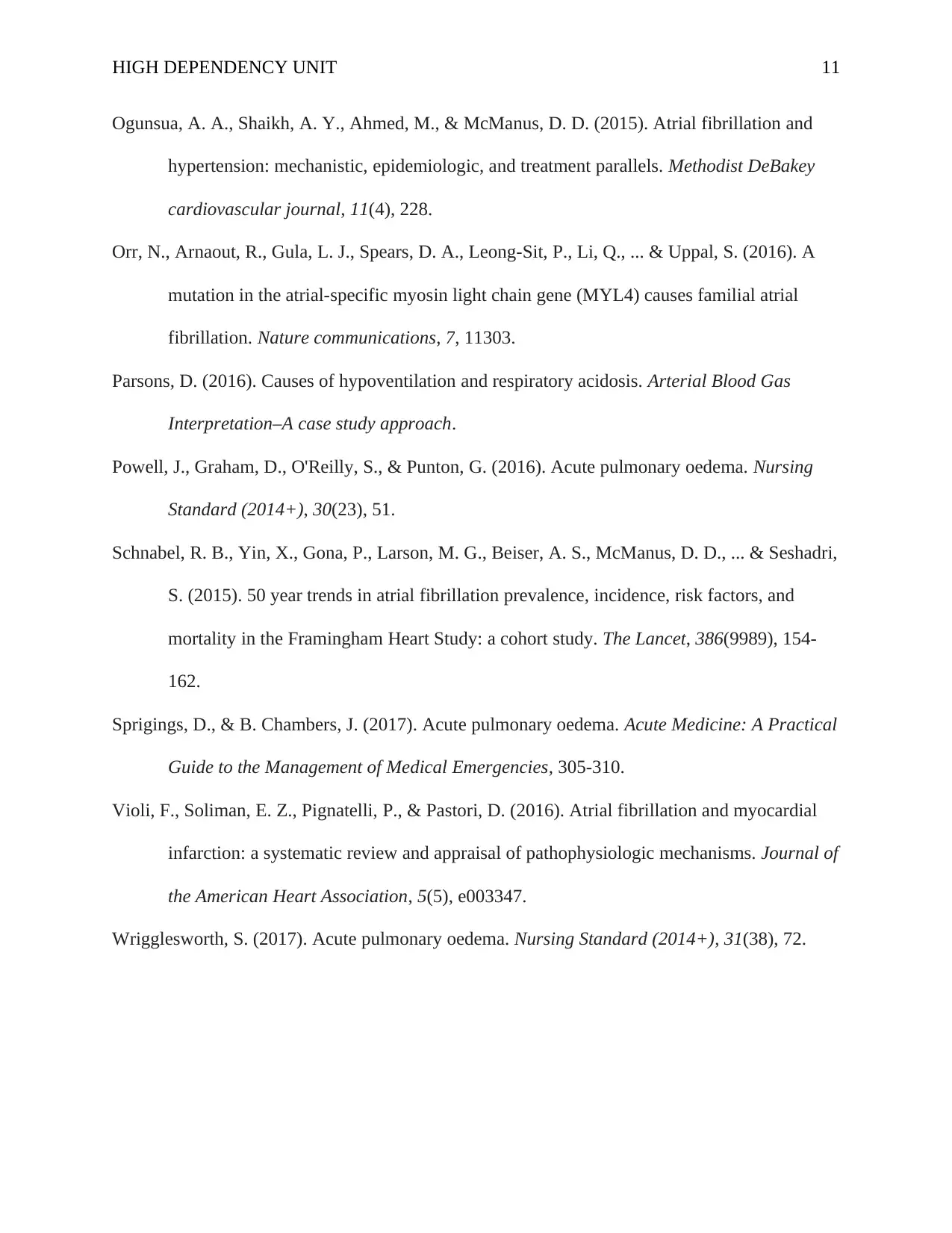
HIGH DEPENDENCY UNIT 11
Ogunsua, A. A., Shaikh, A. Y., Ahmed, M., & McManus, D. D. (2015). Atrial fibrillation and
hypertension: mechanistic, epidemiologic, and treatment parallels. Methodist DeBakey
cardiovascular journal, 11(4), 228.
Orr, N., Arnaout, R., Gula, L. J., Spears, D. A., Leong-Sit, P., Li, Q., ... & Uppal, S. (2016). A
mutation in the atrial-specific myosin light chain gene (MYL4) causes familial atrial
fibrillation. Nature communications, 7, 11303.
Parsons, D. (2016). Causes of hypoventilation and respiratory acidosis. Arterial Blood Gas
Interpretation–A case study approach.
Powell, J., Graham, D., O'Reilly, S., & Punton, G. (2016). Acute pulmonary oedema. Nursing
Standard (2014+), 30(23), 51.
Schnabel, R. B., Yin, X., Gona, P., Larson, M. G., Beiser, A. S., McManus, D. D., ... & Seshadri,
S. (2015). 50 year trends in atrial fibrillation prevalence, incidence, risk factors, and
mortality in the Framingham Heart Study: a cohort study. The Lancet, 386(9989), 154-
162.
Sprigings, D., & B. Chambers, J. (2017). Acute pulmonary oedema. Acute Medicine: A Practical
Guide to the Management of Medical Emergencies, 305-310.
Violi, F., Soliman, E. Z., Pignatelli, P., & Pastori, D. (2016). Atrial fibrillation and myocardial
infarction: a systematic review and appraisal of pathophysiologic mechanisms. Journal of
the American Heart Association, 5(5), e003347.
Wrigglesworth, S. (2017). Acute pulmonary oedema. Nursing Standard (2014+), 31(38), 72.
Ogunsua, A. A., Shaikh, A. Y., Ahmed, M., & McManus, D. D. (2015). Atrial fibrillation and
hypertension: mechanistic, epidemiologic, and treatment parallels. Methodist DeBakey
cardiovascular journal, 11(4), 228.
Orr, N., Arnaout, R., Gula, L. J., Spears, D. A., Leong-Sit, P., Li, Q., ... & Uppal, S. (2016). A
mutation in the atrial-specific myosin light chain gene (MYL4) causes familial atrial
fibrillation. Nature communications, 7, 11303.
Parsons, D. (2016). Causes of hypoventilation and respiratory acidosis. Arterial Blood Gas
Interpretation–A case study approach.
Powell, J., Graham, D., O'Reilly, S., & Punton, G. (2016). Acute pulmonary oedema. Nursing
Standard (2014+), 30(23), 51.
Schnabel, R. B., Yin, X., Gona, P., Larson, M. G., Beiser, A. S., McManus, D. D., ... & Seshadri,
S. (2015). 50 year trends in atrial fibrillation prevalence, incidence, risk factors, and
mortality in the Framingham Heart Study: a cohort study. The Lancet, 386(9989), 154-
162.
Sprigings, D., & B. Chambers, J. (2017). Acute pulmonary oedema. Acute Medicine: A Practical
Guide to the Management of Medical Emergencies, 305-310.
Violi, F., Soliman, E. Z., Pignatelli, P., & Pastori, D. (2016). Atrial fibrillation and myocardial
infarction: a systematic review and appraisal of pathophysiologic mechanisms. Journal of
the American Heart Association, 5(5), e003347.
Wrigglesworth, S. (2017). Acute pulmonary oedema. Nursing Standard (2014+), 31(38), 72.
1 out of 11
Related Documents
Your All-in-One AI-Powered Toolkit for Academic Success.
+13062052269
info@desklib.com
Available 24*7 on WhatsApp / Email
![[object Object]](/_next/static/media/star-bottom.7253800d.svg)
Unlock your academic potential
Copyright © 2020–2025 A2Z Services. All Rights Reserved. Developed and managed by ZUCOL.





